bpmNEXT – Day 1
Blog: Collaborative Planning & Social Business
My notes from first day of bpmNEXT 2015, March 30.
Bruce Silver – Conference introduction
Today we focus somewhere between BPM and Enterprise Architecture. 15 years ago we thought it was huge that we had one system to integrate human and back-end systems, and we have come a long way. Now, there is still too much balkanization of the technology.
Main Themes of the Conference:
- Breaking the barrier between BPM and Enterprise Architecture. Anatoly and another from Comindware is going to talk about the 3 gaps. Denis Gagne will talk about the semantic graph to break down barriers.
- Bridge gap between process modeling and decision modeling. Called “business rules” back then, as if this was an alternative to BPM. Sapiens has started something called the “Decision Model” because this is too important to leave to the existing approach. Signavio will also show business decision modeling.
- Bridge the gap between BPM and Case Management. Camunda is offering a unified BPMN/CMMN execution. Safiro and Cryo will present on how BPM needs to be loosened up. Kofax and IBM will present on mobile case management and capture. How do we do case management on our smart phones. Including signature capture. IBM has put a lot of emphasis on design, so we might see some of that.
- Expanding into new things like the Internet of Things. Presentation from SAP and W4 will focus on this.
- Expanding into expert systems and machine learning. BP3 will present on the automated analysis of bpm code. Fujitsu (Keith) will present on reconciling independent experts. IBM will talk about Watson not just winning Jeaopardy, but how it can be used in the cloud with pre-trained services. Living Systems (Whitestein) measurable intelligence in the process platform.
- Expanding into process mining, and Robert will speak about optimization of resources from this.
- Reaffirming core values of business empowerment. Omny.link puts BPM in WordPress for non-programmers. Oracle will talk about BPM in the public cloud.
- Reaffirm embracing continual change, a presentation by bonitasoft on building “living applications”.
 Nathaniel Palmer – What does BPM will look like in 2020
Nathaniel Palmer – What does BPM will look like in 2020
Today, BPM looks like well defined, fixed routing of packages: channels, switches, but no awareness of what the other packages are doing. Where does it need to be: like an Amazon warehouse with Kiva robots. Needs to be data driver, goal oriented, adaptive, and intelligent automation.
Three things: Robots, Rules, and Relationship.
An illustration of the change from 2005 to 2013 – the smartphone example at the announcement of the new pope.
60% of people switching banks in the past year did so because of insufficient mobile banking capabilities. Mobile support is the most important thing. But don’t just transport the laptop UI to the mobile. Gave an example of an Oldsmobile radio ads that was moved to TV showing a static picture and the radio ad behind it. The new medium affords new forms of content. Showed an automated teller as a “state of automation today” which was obviously not mobile.
What can you do if you have mobile? Kindle Fire has a “MayDay” button — you press and get an instant conversation with a support person. This instant connection enables “relationship”. He showed the Echo from Amazon, because Echo can help walk you through an amazon purchase. Also showed My Jibo which was popularized through a kickstarter campaign. Not to automate tasks, but to interface with tasks.
Another thing is wearables, including wearable workflow. Task might change to not be a single discrete unit of work; remove the distinction between the task and the things that support the task. The three tier architecture is common today. We need to move toward a four tier architecture. Client tier (mobile) delivery tier, aggregation tier, and services tier. JSON and REST, and tasks need to be discoverable.
Process mining and optimization. data driven, goal oriented, adaptive, intelligent automation.
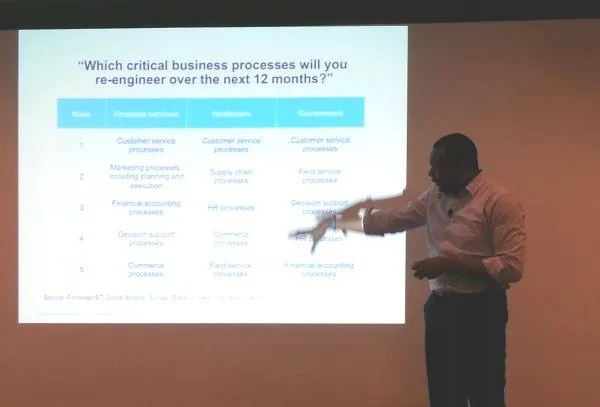 Clay Richardson – Reinventing BPM for the age of the customer.
Clay Richardson – Reinventing BPM for the age of the customer.
Nathaniel’s talk focused on customer experience. 10 years ago much of process was focused on back end systems, and we have changed. Today it is how to engage customers with mobile.
60% of all business leaders prioritize revenue growth and customer experience.
Four periods of history:
- (1900) age of manufacturing,
- (1960) age of distribution,
- (1990) age of information, and finally
- (2010) the age of the customer.
Told a story about a promotion combining Jaguar and Thomas Pink. Packaging was excellent, but reception was completely bad. The bad impression is a perfect example of a process failure: the dealer had not been informed, they were not prepared, not engaging. Was really wanting a memorable, rich, engaging experience.
Big challenge today is to get across from the old to the new. 42% of business people put better mobile support on critical or high priority. Examples of new mobile apps to order pizza from Pizza Hut and Dominos. Pizza Hut simply ported their web site to the phone and it took about 20 minutes to make the first order. Dominos on the other hand made something that works very well: easy to order, buttons for what you ordered last time, and has a tracker to tell you where it is. Another example is buying US savings bonds. Clay helped to redesign this, and found that the changes required broke many of the assumptions in the back end systems.
BPM people don’t have a lot of credibility for improving customer experience. Need a new title “Digital Customer Experience Arcthitect”. First, digitize customer end-to-end experience, Another is “Digital operational excellence architect” for drive rapid customer centric innovation and to support prototyping.
What has to change in BPM?: He produced a customer centric BPM Tech Radar. Two key items on this chart: 1) low code platforms. 2) customer journey mapping. Simple cloud orchestration, how to quickly program devices, how to connect devices.
Customer facing cadence is faster. The real thing is really a need for speed. Months to get things done. Now when touching customers we need to work faster. This is driving to “low code” approach. Develop in weeks, releases weekly, method is test and learn, and adoption is intuitive now.
Gave an example of a customer journey from Philips medical devices to sell a life alert bracelet. Opportunity to redesign the delivery because the older patient is often anxious, and the purchasing customer needs to be informed. Another issue was billing since that was being split three ways, make it easier to do this.
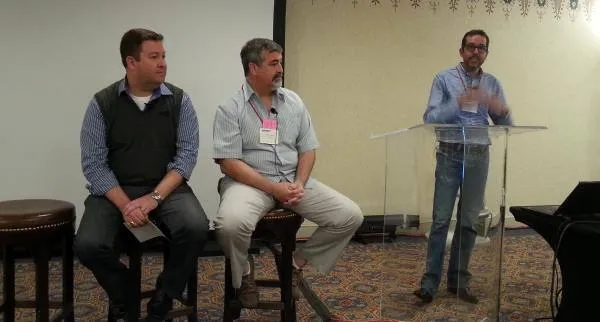 Panel on BPM Business
Panel on BPM Business
- Miguel Valdes Faura – Bonita Soft
- Scott Francis – BP3 Global
- Denis Gagne – Trisotch
Miguel – Open Source is the key to building a successful ecosystem. Akira Awata has translated the entire platform into Japanese and there is a big uptick in usage. Before that, downloads in Japan were limited. Open Source BPM Japan. Now reselling subscription to businesses like Bridgestone and Sony. Bonita BPM Essentials book developed on the open source version, and people can download and access the examples. Banking regulation is changing in Switzerland, and some are using processes in Bonita to match these new rules. There are large benefits to the open source model.
Scott Francis – How to move from Lombardi to independent. Started trying to be the best Lombardi partner, and then IBM partner. People worry about time, money, and focus, and it is focus that is the easiest to lose track of. Learned to find our own customers – IBM did not refer anything. Service providers get a lot of pressure to pick up other products, for example pick up more IBM products, but it might be better to focus on one product and do the job really well.
Denis Gagne – Two hobbies: Building an Ecosystem of BPM & standards work. Still amazed at how much “BPM-101” needs to be taught. There is a need for us as a general community to educate better. BPM Incubator has more members outside of US than inside. 190 countries. We all benefit if the BPM community is better informed.
Q: (Neil) Convergent vs. Divergent Standards. Why do standards sometimes work, and sometimes not?
A: it is easier to have agreement when you are only touching one set of customers. Bonita has 1000 customers, but they use only about 30% of BPMN.
Q: (Bruce) People are building Apps. If the problem that the BPM platforms don’t provide something suitable for those Apps?
A: (Miguel) This is an important questions. How to make sustainable apps. We have been doing a poor job in the BPM industry in helping people to make customized UI. There is a portal, and there is a level of customization, but you are constrained to the box. You can’t say, put a button on the right corner of the screen. How to change?
- Low-code approach to avoid the need for developers,
- instead making things that support developers to make them more powerful.
(Scott) A lot of the people doing mobile apps, have no concept of process. Once the data is shipped back to the server, they don’t care where it goes. Opportunity to fill the gap between mobile and back end.
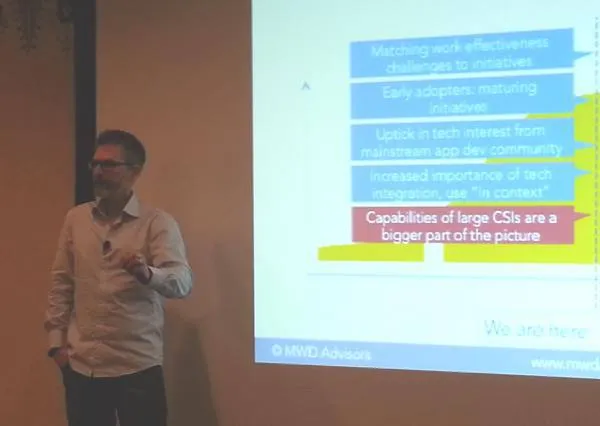 Neil Ward-Dutton – Schroedinger’s BPM
Neil Ward-Dutton – Schroedinger’s BPM
Is this the end of BPM? Are we seeing the end of “business transformation”. Where are we going next?
Is it dead?: the term BPM is disappearing from conversations. People don’t want to talk about it. Instead they use smart process, case management, anything else. BPM Technology platforms growing at 3%. (Clay thinks 8%) Maintenance revenue is dominating license revenue. However, there is a lot of inquiries, particularly from non-traditional sectors. Actually we are probably in the very middle of the adoption curve.
BPMS is fundamentally unlike most enterprise technologies. Really weird and horrible chimera. Hard to map on the ways that people normally work. The innovators think they can use BPM to reinvent the way they work. But the mainstream reject as having tried it and wasted time and money. Just another attempt to get us locked into a enterprise platform. Culture change is too expensive..
Someone created a “Customer Project Manager” to help premium in-home customer services. Didn’t call it BPM. This was about agility. Another example was a large bank who has a IT led enterprise wide transformation failed big time.
They are embracing cloud aggressively. They are using agile ways of working. Low cost propositions. The lightweight approaches are about spending less up front. Why are there all these people out there building these apps, but not really engaging with the back-end. The culture change is not coordinated: it is too scary.
Low-code is what we used to call 4GL.
New agile enterprise has no “target operating model.” They don’t know what it will be. This is not the way we did transformation ten years ago. First instrument, then provide agility of services.
Why would you do “simulation” when you could put the real solution in the hands of real users and observe how it works?
Customer journey slide very interesting. Knowing customer is not enough, build surfacing, on that acting and finally shaping. That all needs to be done across marketing, sales, operations, and service.
Advice: don’t fixate on SPA’s, don’t obsess over traditional competitors, don’t fixate on throwing more in the box, do find ways to enhance BYOP particularly with auditability, do look at the implications of digital strategies, do enable clients to take the portfolio management approaches to business processes, do partner, buy, build.
 Remy Glaisner – Myria Research – Chief Robotics Officers and BPM
Remy Glaisner – Myria Research – Chief Robotics Officers and BPM
RIOS – Robotics and Intelligent Operational Systems. Automation, Robotics, and mobile technologies. There will soon be many people calling themselves “Chief Robotics Officers.” This is a completely open, nascent field — no leaders yet. inflection point expected in 2017-2018. For manufacturing they are already there, but agriculture is a ways off.
Client acquisition is based largely on how fast you can deliver. Automation including robotic automation, is quite important.
By 2025 over 60% of manufacturers over $1B will have a Chief Robotics Officer (CRO) on staff.
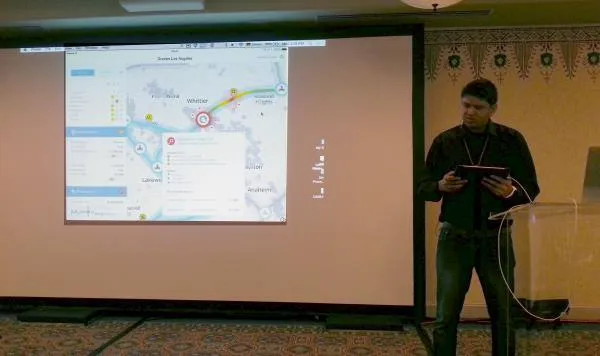 Benjamin Notheis, Harsh Jegadeesan
Benjamin Notheis, Harsh Jegadeesan
Internet of Things. There are others: Internet of People, Internet of Places, and Internet of Content. All four of these together. Wil vdAalst talks about the Internet of Events. IoE means massive data (bigger than big data). Event stream processing sense patterns in real time. Once a pattern is identified, one can response with rules and processes.
Presented a use case about a person who managed pipelines in L.A. Events notify that there is a problem. The options to replace a pump are given, different prices, different quality of pump. Demo is hard to describe here — so see the video. At one point he assigned a task to someone just typing “@manny escalate issue” the user was found and task assigned. Very dynamic! Had a visual depiction of incidents displayed as tiles, where the size of the tile represnts the number in that category.
The coolest part of the demo was when he showed the user interface display on a watch display. One could see the task, see the data values and options, make an audio annotation of the task, and mark the task as completed. All from the watch.
Eclipse based modeler showing extended BPMN. Models can be imported to http://bpmn.io. This is compiled to JavaScript for running in the SAP cloud service. Referred to it java script event loop.
Q: does this use NetWeaver and/or work with it? A: Basically, not much. It is a new process engine implemented over the last 6 months or so.
Francois Bonnet, W4
Francois gave a great presentation and demo around a use case of monitoring elderly and responding to falls. Showed a “faintness sensor” based on a raspberry pi processor. When it tilted for more than a few seconds, it started a BPMN process. A heartrate event might cause this process to escalate to various steps, such as calling them, calling a neighbor, and sending in a response team. If it got back upright, the process was cancelled. If the fall happened too many times in a particular period, it started a different process.
It was pretty interesting that the event modeling was done effectively in BPMN, however the aggregate even (falling too many times in a period) was not modeled directly in BPMN.
Dan Neason, Living Systems
Covered the Whitestein system. All processes have a reflection capability so you can ask a running model what it is capable of doing. Interesting demo, but hard to capture here.
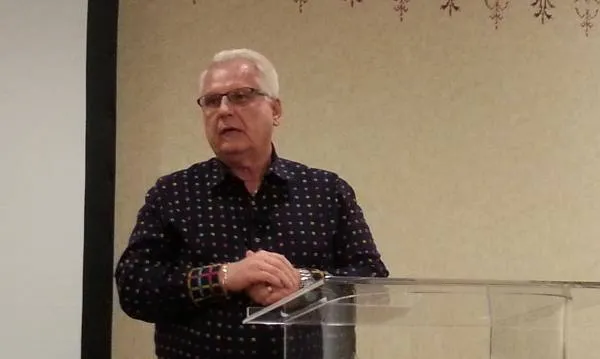 Jim Sinur – Swarming and Goal Directed Collaborative Processes
Jim Sinur – Swarming and Goal Directed Collaborative Processes
BPM is not a sexy term any more. What else do we go to? There is a notion of a Hybrid Processes. Could go on that, but as Neal pointed out, growth is not that high.
The idea we should follow is that of transforming the digital organization. How do processes help organizations become digital organizations.
Got some of this from Keith’s presentation last year where he showed a video of starlings flocking (murmerating). The idea is that birds guided by simple rules can act collectively in an emergent way. But we ned to think about flocks with starlings, ducks, geese, sparrows, etc. We will have swarms of things, but they consist of robots, information systems, and everything else.
Processes should help organizations cope with the “big change” coming their way. We force customers to go through a phone menu which matches the organization that was designed on industrial age ideas. Why force the customer to this? Tomorrow there will be an “Uber” in every different industry.
Gave an example of an insurance company that wanted general reps to be able to handle all products. They used AI systems to help. Tried to get rid of specialization, but they failed because the rules technology was not available.
In production in Norway is a company to help with dementia patients. Gave them a wristband with GPS in there. If the patient approaches or crosses a boundary, they are notified and and go get him.
“Going digital” is the goal. A couple of way to get there. “do it, try it, fix it” is one approach. Today the process is often in control. But in the future the goals are in control of work and the process.
Can you imagine a bunch of swarming agents deciding what to do next? Agents are: level of humanity, level of collaboration, level of intelligence, and a vector in goal driven freedom. Hybrid resourceses, hybrid process styles (cases, flows, forms), hybrid speed, hybrid goals, etc.
Example of a bike store that has a kiosk that analyzes the customer to determine what mood, what kind of personality, and body type. She keys in information about the kinds of riding she would like, and it suggests a bike. Imagine that there were many of these intelligent agenst swarming to help sell this bike.
Another exmple is using a swarm to find a suitable house by sending in a photo of the kind of house you want. It could search for similar homes, and a bank might do this in order to also offer a mortgage. Issues with autonomous cars and robots: legal issues. Who do you sue when something goes wrong?
Not just UI, not just mobile, but how you treat customers and how you meet their need is the important thing.
That is it for the first day. Then it was off to winetasting on the roof-top patio.

